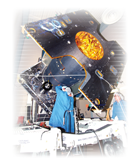| |
             
3. Transmission Modes
3.1. Television
The regulatory regime for television programme services in Hong Kong provided under the Broadcasting Ordinance (BO) (Cap.562) is technology-neutral9. Licensees are free to choose their transmission arrangements for the delivery of television services. The broadcasters can build their own transmission networks to deliver their services and, in such cases, they need to apply for a carrier licence from the Telecommunications Authority to cover the transmission network. Alternatively, they can engage any of the existing carrier licensees to provide the transmission service. The licensees can also provide their television programme services via multiple transmission platforms so as to maximise the coverage.
3.1.1 Terrestrial Transmission
ATV and TVB provided their television programme services both in analogue PAL-I format and digital National Standard format via the UHF radio frequency band. They are required to provide service throughout Hong Kong under the BO and to construct new transposers as directed by the Authority to improve reception in areas with reception problems10. For analogue broadcasting, the Authority has since 1995 directed ATV and TVB to build a total of 17 TV transposers to serve pocket areas not covered by the six main transmission stations11 and supplementary transposers. As of August 2008, there were a total of 40 station-operated television transmitting stations and 11 community self-help transposers12 serving the territory. For DTT broadcasting, the Authority has approved the plans of ATV and TVB to roll out their services in phases by constructing six main transmission stations13 to reach the coverage of 50% of the population of Hong Kong upon official launch on 31 December 2007, to extend the coverage to 75% by the end of 2008. ATV and TVB attained the 75% coverage by August 2008 ahead of their original schedules. ATV and TVB are also required to achieve coverage equivalent to or better than the current analogue coverage by 2011 with the construction of 23 fill-in transmission stations. Preparations are underway by ATV and TVB to construct these fill-in stations.
| Figure 8: |
List of Transposers for Analogue Broadcasting Constructed by ATV and TVB as Directed by the Authority since 1995 |
Transposer Site |
Direction by the Authority |
Completion Date |
Pokfulam Village |
1995 |
1996 |
Tui Min Hoi, Sai Kung |
1996 |
1996 |
Sham Tseng |
1996 |
1996 |
Tsing Yi |
1997 |
1997 |
Ying Pun |
1997 |
2003 |
Yuen Long Town Centre |
1998 |
2003 |
Tseung Kwan O Village |
1998 |
2001 |
Hang Hau Village |
1999 |
2002 |
Tuen Mun Village |
1999 |
2002 |
Tung Chung Village |
2000 |
2003 |
Fuk Hang Tsuen and
Fu Tei of Tuen Mun |
2000 |
2001 |
Central & Western Districts |
2001 |
2002 |
Kau Wah Keng |
2001 |
2003 |
Tai Pak Tin area of Kwai Chung |
2002 |
2004 |
Cheung Chau |
2002 |
2004 |
Cha Kwo Ling |
2004 |
2005 |
Ap Lei Chau & Aberdeen |
2004 |
2007 |
3.1.2 Hybrid Fibre Coaxial Cable (HFC) and Microwave Multipoint Distribution System (MMDS)
HKCTV delivered its domestic pay television programme service mainly by hybrid fibre coaxial cable (HFC) network, supplemented by microwave multipoint distribution system (MMDS) and satellite transmission. As at August 2008, HKCTV's network covered around 2.2 million households, i.e. 97% of the total households in Hong Kong.
3.1.3 Satellite Transmission
Since the launch of service in February 2004, TVB Pay Vision has been employing satellite to transmit a pay television service to some of its subscribers. In September 2004, HKCTV added satellite transmission mode to deliver its service.
Up to August 2008, there were 16 non-domestic television programme service licensees. All of them employed satellites to transmit their television services to the region. The satellites used were AsiaSat2, AsiaSat 3S, AsiaSat 4, Apstar IIR, Apstar V, Apstar VI, Intelsat 10, Intelsat 8, NSS 6, Eutelsat W5 and Measat 3. |
 |
Viewers in multi-storey buildings can receive satellite television channels directly through SMATV systems. In August 2008, the SMATV systems covered 779 185 households in Hong Kong, representing 34.6% of the total households.
3.1.4 Broadband Network
PCCW Media's "now Broadband TV" service was delivered over the asymmetrical digital subscriber line (ADSL) broadband network operated by PCCW-HKT Telephone Limited (PCCW-HKT) through PCCW-HKT's telephony network, which achieved near universal coverage in Hong Kong. |
 |
In August 2005, TVB Pay Vision also started to employ the broadband network via Hutchison Global Communications Limited (HGC) to deliver its domestic pay TV service. On 10 May 2006, TVB Pay Vision launched its service on the transmission platform of PCCW Media, which could be accessed via the same set-top box of PCCW Media with a separate electronic programming guide which is distinguishable from that of PCCW Media's "now Broadband TV" service.
| Figure 9: |
Coverage of Different Television Transmission Modes |

| Figure 10: |
Transmission Modes Employed by the Television Licensees |
Licensee |
Transmission Mode |
| Domestic Free Television |
| |
ATV and TVB |
|
Terrestrial UHF (Analogue + Digital)
|
Domestic Pay Television |
| |
HKCTV |
| |
PCCW Media |
| |
TVB Pay Vision |
|
HFC, MMDS and satellite (Digital)
Broadband network (Digital)
Satellite and broadband network (Digital) |
Non-domestic Television |
| |
All the 16 licensees |
|
Satellite (Digital) |
| 9 |
An exception is that a service consists only of a service provided on the Internet is exempted from the regulatory regime under the BO.
|
| 10 |
According to the guideline issued by the Authority, the licensees will normally be exempted from serving those areas where the populations affected by poor television reception are below 2 000 persons within an area of a radius of three kilometers.
|
| 11 |
Temple Hill, Golden Hill, Castle Peak, Kowloon Peak, Cloudy Hill and Lamma Island.
|
| 12 |
Self-help transposers refer to the TV transposers built by parties other than the domestic free television programme service licensees (for example, by the estate developers).
|
| 13 |
The six transmission stations are Temple Hill, Kowloon Peak, Castle Peak, Golden Hill, Lamma Island and Cloudy Hill.
|

|
|


